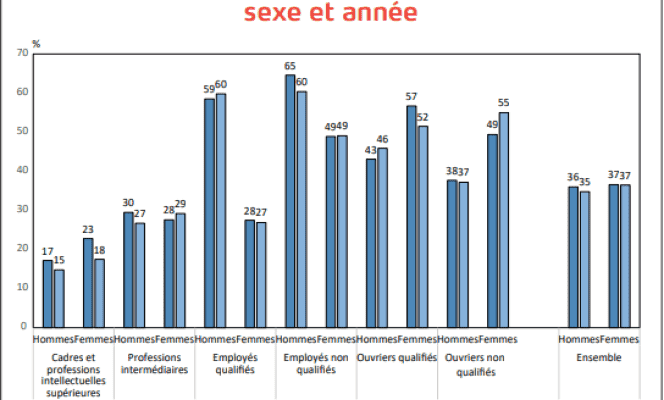Working before 7 a.m. in the morning, after 8 p.m. in the evening, at night or on weekends… These so-called “atypical” hours concerned 36% of employees in France in 2019, according to a study published on Wednesday April 27 by the National Institute for Demographic Studies (INED). A ratio “massive”according to Anne Lambert, sociologist and author of this study, questioned Wednesday on France Inter. The figure has been stable over the last decade, according to the INED report, but has increased over twenty years, in particular due to the uberisation of the economy and the development of work on Saturdays and Sundays.
Above all, it hides divergent realities between levels of qualification and between the sexes. According to one of the main findings of this study, women are now proportionally more numerous than men to work with atypical hours (37% against 35%). Among them, the least qualified are the most affected and those whose exposure to atypical working hours has increased the most. Managers, on the other hand, experience a “relative normalization of their working hours”but still have to deal with schedules “unpredictable and variable”.
“The share of female executives working atypical hours decreased by 23% between 2013 and 2019, while it increased by 11% for unskilled workers. Among men, social polarization is less marked. The proportion of executives working atypical hours fell by 14% while that of unskilled workers stagnated”finds the study, carried out on the basis of the “Working conditions” surveys of the direction of the animation of research, studies and statistics.
Women work more on weekends
The study explains:
“On the one hand, work-family reconciliation policies in large companies have helped to improve the working conditions of the most highly qualified (…). On the other hand, low-skilled women are over-represented in retail trades where Sunday work has increased (saleswoman, cleaner, etc.) as well as in personal service trades (caregiver, home help, household), where atypical working hours are structural. »
“However, while evening and night work fell slightly between 2013 and 2019, Saturday, Sunday and morning work (from 5 a.m. to 7 a.m.) increased for certain categories of employees”, according to the study. The authors see this as a consequence of the laws which have extended the derogatory use of Sunday work and favored the modulation of working time.
Again, there are marked differences between the sexes. Women work more often on Saturdays and Sundays, while proportionally more men work early in the morning, in the evening and especially at night. However, their exposure to atypical working hours tends to be reduced.
Cumulative constraints
Among these employees subject to atypical hours, many are those who combine other constraints: variable hours from one day to another for 35% of them, discontinuous days, with work interruptions of at least least three hours (9%) or times known at most the day before (12%). The association between atypical working hours and gender varies both according to socio-professional category and according to the sector of activity, also notes the INED report. “Unskilled female workers frequently work as cleaners while men are more often laborers in the construction industry, where daytime and weekday hours are more frequent”cites the study as an example.
Here again, low-skilled women are particularly affected. Unskilled workers and employees are thus more often faced with intermittent days and unpredictable schedules. According to the study, this group of “small fragmented times and unpredictable schedules” brings together 18% of employees.
However, the study does not make it possible to know whether these atypical hours are the result of a choice by the employees or of a constraint. On France Inter, Anne Lambert mentioned a proportion of two thirds of employees who would be forced to do so. Among the third of the people who make the choice, the sociologist estimates that it is mainly about women with very young children.
